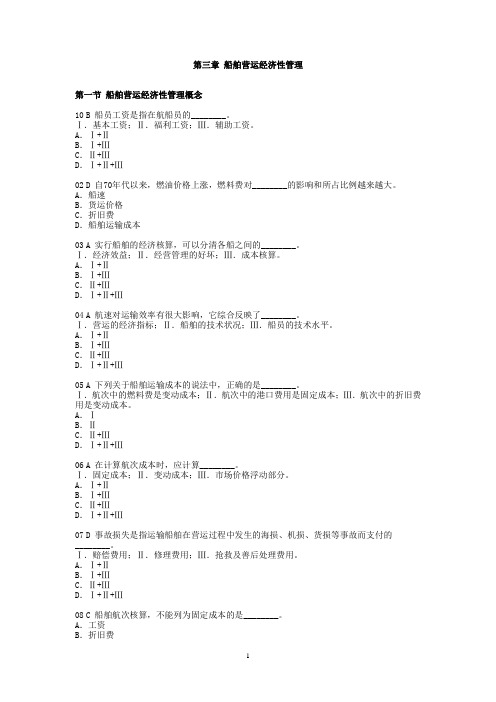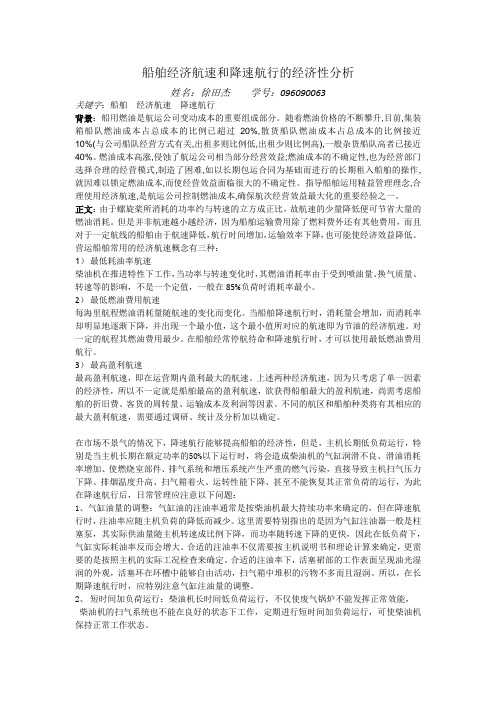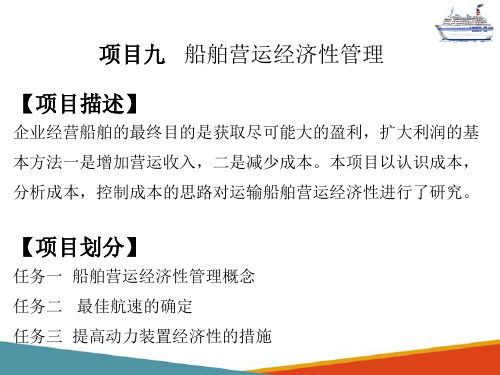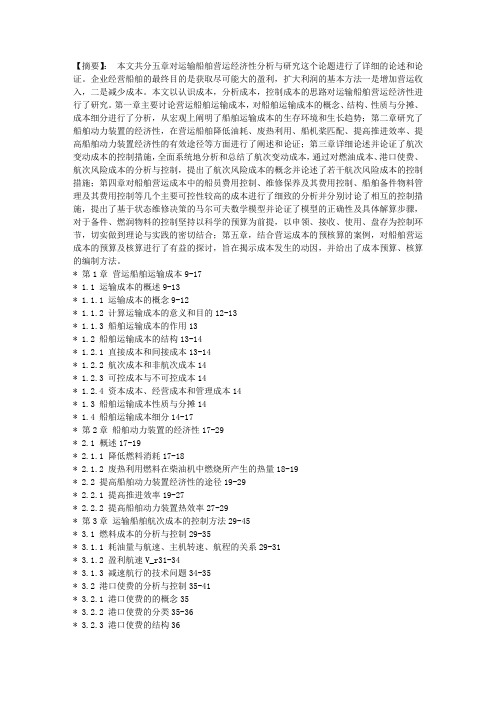船舶营运经济性
第三章 船舶营运经济性管理

第三章船舶营运经济性管理第一节船舶营运经济性管理概念10B 船员工资是指在航船员的________。
Ⅰ.基本工资;Ⅱ.福利工资;Ⅲ.辅助工资。
A.Ⅰ+ⅡB.Ⅰ+ⅢC.Ⅱ+ⅢD.Ⅰ+Ⅱ+Ⅲ02D 自70年代以来,燃油价格上涨,燃料费对________的影响和所占比例越来越大。
A.船速B.货运价格C.折旧费D.船舶运输成本03A 实行船舶的经济核算,可以分清各船之间的________。
Ⅰ.经济效益;Ⅱ.经营管理的好坏;Ⅲ.成本核算。
A.Ⅰ+ⅡB.Ⅰ+ⅢC.Ⅱ+ⅢD.Ⅰ+Ⅱ+Ⅲ04A 航速对运输效率有很大影响,它综合反映了________。
Ⅰ.营运的经济指标;Ⅱ.船舶的技术状况;Ⅲ.船员的技术水平。
A.Ⅰ+ⅡB.Ⅰ+ⅢC.Ⅱ+ⅢD.Ⅰ+Ⅱ+Ⅲ05A 下列关于船舶运输成本的说法中,正确的是________。
Ⅰ.航次中的燃料费是变动成本;Ⅱ.航次中的港口费用是固定成本;Ⅲ.航次中的折旧费用是变动成本。
A.ⅠB.ⅡC.Ⅱ+ⅢD.Ⅰ+Ⅱ+Ⅲ06A 在计算航次成本时,应计算________。
Ⅰ.固定成本;Ⅱ.变动成本;Ⅲ.市场价格浮动部分。
A.Ⅰ+ⅡB.Ⅰ+ⅢC.Ⅱ+ⅢD.Ⅰ+Ⅱ+Ⅲ07D 事故损失是指运输船舶在营运过程中发生的海损、机损、货损等事故而支付的________。
Ⅰ.赔偿费用;Ⅱ.修理费用;Ⅲ.抢救及善后处理费用。
A.Ⅰ+ⅡB.Ⅰ+ⅢC.Ⅱ+ⅢD.Ⅰ+Ⅱ+Ⅲ08C 船舶航次核算,不能列为固定成本的是________。
A.工资B.折旧费D.保险费09D 水运企业的船舶将________的修理费用合并,并以修理基金分期提存的方式计入成本。
Ⅰ.检修;Ⅱ.小修;Ⅲ.航修。
A.Ⅰ+ⅡB.Ⅰ+ⅢC.Ⅱ+ⅢD.Ⅰ+Ⅱ+Ⅲ10B 燃料价格包括________。
Ⅰ.购入价;Ⅱ.区域差价;Ⅲ.加油费用。
A.Ⅰ+ⅡB.Ⅰ+ⅢC.Ⅱ+ⅢD.Ⅰ+Ⅱ+Ⅲ11C 船舶营运中的废旧料,应当________。
Ⅰ.定期收回交库;Ⅱ.作价冲减材料费;Ⅲ.卖掉留船自用。
船舶运行的经济性

4-2-6图 燃料价格变化时的影响
• 二、营运船舶的经济航速
• 1.最低耗油率航速:当主机在耗油率最低情况下运行时,
•
船舶的航速。
•
一般在80%Pb下,按推进特性工作的主机燃油耗油率最低。
•
见4-2-7图
•
若柴油机在航行时经常处于较高负荷工作,•Biblioteka 应尽量选择这个航速。•
2.最低燃油费用航速:每海里航程燃油消耗量最低时的船舶
• a.废气锅炉部分或全部代替辅锅炉 • b.废气锅炉全部代替辅锅炉,并部分代替发电柴油机 • c.废气锅炉全部或部分代替发电柴油机 • d.废气锅炉全部用于发电柴油机和部分代替辅锅炉 • e.废气锅炉全部代替发电柴油机和全部代替辅锅炉 • f.冷却水余热利用驱动汽轮发电机或造淡水或空调系统加热作上
4-2-7图 ge-P曲线
4-2-8图 Gn-v曲线
4-2-9图 最低单位运输成本的航速
曲线A-R大(t2/t小) 曲线B-R小(t2/t大)
4-2-10图 最佳经济航速
1-标准年收入 2-标准年成本 3-运费增加时的年收入 4-燃料费减少时的年成本
• 三、航速对续航力的影响
• L=v·t
述5种方案的补充 • 目前船上已普遍采用方案a和方案b
• 二、船舶余热利用的形式
• 船上余热利用的形式例举如下
•
1.形式1见4-3-1图
•
2.形式2见4-3-2图
•
3.形式3见4-3-3图
•
4.形式4见4-3-图
•
5.形式5见4-3-5图
•
6.形式6见4-3-6图
•
7.形式7见4-3-7图
•
8.形式8见4-3-8图
船舶的燃料消耗与经济性评估

,具有降低潜力。
02
经济性评估
通过对比同类船舶及市场平均水平,发现该船在运营成本方面存在优化
空间。
03
改进建船体线型设计
、采用节能型推进系统等措施;针对经济性不佳的问题,建议加强成本
控制、提高装载率、拓展市场渠道等。
THANKS
感谢观看
REPORTING
盈利能力和市场竞争力。
运输效率
反映船舶在单位时间内完成的 运输量,与船舶的设计、运营 管理和市场环境密切相关。
环保性能
随着环保法规的日益严格,船 舶的环保性能已成为评估其经
济性的重要因素之一。
综合评价指标体系构建
构建原则
遵循科学性、系统性、可操作性和动 态性原则,确保评价指标的全面性和 准确性。
指标体系
包括船舶能效指标、营运经济指标、 运输效率指标和环保性能指标等,以 全面反映船舶的经济性。
权重分配
根据各指标对船舶经济性的影响程度 ,采用专家打分法、层次分析法等方 法确定各指标的权重。
综合评价
将各指标值进行无量纲化处理,加权 求和得到综合评价结果,以直观反映 船舶的经济性水平。
PART 03
船舶运营成本控制策略
设立了国内船舶排放控制区,对进入控制区的船 舶实施更严格的排放要求,以促进船舶减排和环 保。
国内船舶能效管理政策
要求船舶在运营过程中实施能效管理计划,通过 优化航线、减少空驶、提高装载率等措施降低燃 料消耗。
政策法规对船舶经济性影响分析
燃料成本增加
随着环保政策的加严,船舶需要使用低硫燃油或安装脱硫装置等来满足排放要求,这将增加船舶的燃料成本 。
率。
效果评价及推广前景
效果评价
节能减排技术的应用显著降低了船舶的燃料消耗和排放污染,提高了船舶的经济 性和环保性能。
第六章 船舶营运的经济性及节能措施

图4 装卸效率变化时的影响
1-装卸效率=500t/d 3-装卸效率=2000t/d
2-装卸效率=1000t/d 4-装卸效率=5000t/d
图5 造价变化时的影响
1-造价为100% 2-造价下降25% 3-造价下降50%
图6 燃料价格变化时的影响
营运船舶的经济航速
1. 最低耗油率航速:当主机在耗油率最低情况下运行时,船舶的航速。 一般在80%Pb下,按推进特性工作的主机燃油耗油率最低。 见图7 若柴油机在航行时经常处于较高负荷工作,应尽量选择这个航速。 2. 最低燃油费用航速:每海里航程燃油消耗量最低时的船舶航速。 见图8 若柴油机经常停航待命和降速航行时,应使用改行速。 3. 最高盈利航速(也称最佳航速): 船舶最大盈利的航速(也就是船舶消耗最少的航速) 考虑因素:船舶的折旧费、客货周转量、航行时间、工资、运输成本 见图9 当运费增加时和燃料费下降时,最佳航速可以提高。 见图10
Rf = Qf Qt ⋅ R ⋅ 10 −3
R f — 千吨海里(公里)燃料消耗,kg/kt·n mile;
— 船舶年燃料消耗量,t; Q f — 年运输量,t; Q t — 年航程,n mile。
现代工程经济分析中采用的经济指标
随着经济与财务因素的复杂化,上面所述的一些 经济指标越来越显现出它们的不足之处,现代工程经 济分析必须考虑下列因素: (1)资金的时间价值,特别是投资在整个营运年限 中的价值变化; (2)在整个营运期中,营运收入和各项费用的变化; (3)经济与财务因素,如贷款、津贴、税金和折旧 等。 考虑了以上因素后,现在国内外常用下列经济指标:
净现值NPV 净现值
把各年的收入和支出,按投资收益率折现后相减的 结果。其含义是考虑到资金的时间价值后,在使用期 内,能获得利润(还本付息后)的总现值。当其值为 零时,方案收支相抵,恰能达到预期的投资收益率。 如所得值为正,表示可以超过预定的投资收益率,如 所得值为负,表示达不到预定的投资收益率,即 n NPV = ∑ [ PWi ×(当年收入)-(当年营运成本)- PWi × 1 (当年投资)]+ PWn ×(船价残值) PWi — 现值因素,按i=1,2,…,n逐年计算 PWi = (1 + i ) − n n— 船龄
《船舶管理(轮机)》课程标准

《船舶管理(轮机)》课程标准课程代码:课程类型:理实一体课课程性质:必修课适用专业:轮机工程技术总学时:72一、课程性质与作用《船舶管理(轮机)》是海洋船舶轮机工程技术〈轮机管理〉专业核心课程,是海船船员三管轮适任考试课程之一,是从事船舶机械设备运行、维护、安装、调试,航运部门机务管理必备的课程。
二、课程目标1、课程总体目标:通过任务引导的项目活动,掌握海员培训、发证和值班标准国际公约(STCW 公约)关于船舶管理的理论知识;掌握船舶结构、营运、适航性、防污染、人员管理、资源管理等方面的知识,具有一定的船舶营运中的业务分析能力和事件、事故解决能力;满足国家海事局对海船三管轮适任标准的要求和航运企业对操作级轮机员的技能要求。
2、具体目标1)知识教学目标(1)船舶结构及其适航性的基本知识。
(2)船舶防污染的国际公约、国内法规及防污染设施。
(3)船舶营运安全管理及其相关的国际公约与国内法规。
(4)船舶营运经济性管理知识。
(5)船舶安全操作及应急处理的知识。
(6)船舶人员管理及其相关的国内、外法规。
(7)船舶油类、物料及备件管理知识。
(8)机舱资源管理知识。
2)能力培养目标(1)具备保持船舶适航性的能力。
(2)具备正确执行ISM规则和IMo法规的能力。
(3)具备防止海洋环境污染的能力。
(5)具备机舱资源管理的能力。
3)素质培养目标(1)具有诚实守信,认真负责、积极向上的职业精神和职业道德意识。
(2)具有热爱科学、实事求是的学风;具有创新意识和创新精神,不断探索和研究船舶管理发展趋势和新的技术。
(3)树立科学发展观,注重生态环保;执行行业标准和法规,注重技术安全和劳动保护。
(4)掌握人际交往的基本技巧,具有懂得沟通、讲究协作和善于获取信息的能力。
三、课程设计理念与思路课程设置依据:依据STCW78公约马尼拉修正案、国家海事局高级船员最新考纲和现代船舶轮机管理的工作需求设置“船舶管理”课程,对应操作级船员”船舶作业与船员管理功能”岗位功能模块;同时考虑到“以职业素质为基础,以适岗能力为本位”的教育教学指导思想和航海高职高专学生的认知规律,以满足远洋船舶轮机人才需求、船舶轮机岗位群能力的需求和对于高级船员的适任要求。
船舶经济航速分析

船舶经济航速和降速航行的经济性分析姓名:徐田杰学号:096090063关键字:船舶经济航速降速航行背景:船用燃油是航运公司变动成本的重要组成部分。
随着燃油价格的不断攀升,目前,集装箱船队燃油成本占总成本的比例已超过20%,散货船队燃油成本占总成本的比例接近10%(与公司船队经营方式有关,出租多则比例低,出租少则比例高),一般杂货船队高者已接近40%。
燃油成本高涨,侵蚀了航运公司相当部分经营效益;燃油成本的不确定性,也为经营部门选择合理的经营模式,制造了困难,如以长期包运合同为基础而进行的长期租入船舶的操作,就因难以锁定燃油成本,而使经营效益面临很大的不确定性。
指导船舶运用精益管理理念,合理使用经济航速,是航运公司控制燃油成本,确保航次经营效益最大化的重要经验之一。
正文:由于螺旋桨所消耗的功率约与转速的立方成正比,故航速的少量降低便可节省大量的燃油消耗。
但是并非航速越小越经济,因为船舶运输费用除了燃料费外还有其他费用,而且对于一定航线的船舶由于航速降低,航行时间增加,运输效率下降,也可能使经济效益降低。
营运船舶常用的经济航速概念有三种:1)最低耗油率航速柴油机在推进特性下工作,当功率与转速变化时,其燃油消耗率由于受到喷油量、换气质量、转速等的影响,不是一个定值,一般在85%负荷时消耗率最小。
2)最低燃油费用航速每海里航程燃油消耗量随航速的变化而变化。
当船舶降速航行时,消耗量会增加,而消耗率却明显地逐渐下降,并出现一个最小值,这个最小值所对应的航速即为节油的经济航速。
对一定的航程其燃油费用最少。
在船舶经常停航待命和降速航行时,才可以使用最低燃油费用航行。
3)最高盈利航速最高盈利航速,即在运营期内盈利最大的航速。
上述两种经济航速,因为只考虑了单一因素的经济性,所以不一定就是船舶最高的盈利航速,欲获得船舶最大的盈利航速,尚需考虑船舶的折旧费、客货的周转量、运输成本及利润等因素。
不同的航区和船舶种类将有其相应的最大盈利航速,需要通过调研、统计及分析加以确定。
从经济性角度对船舶运力构成的趋势分析

从经济性角度对船舶运力构成的趋势分析发表时间:2018-09-18T09:46:51.273Z 来源:《知识-力量》2中作者:唐晓陈玉兰宋洪辉[导读] 浩瀚的海洋占地球表面总面积的71%,大海把许多国家分隔开,曾令人类“望洋兴叹”。
随着社会和科技进步,现在在这片蔚蓝的大海为人类提供了“舟楫之力”,成为连接全世界各国经济的文化纽带。
目前,由于海上运输具有运量大、成本低的优点在全世界80%以上的国际货物通过船舶运输,在我国国际航运约占外贸货物运输的90%。
随着世界经济的全球化,国际航运的作用和地位将会越来越重要,而且是其他运输方式无法替代的。
(重庆交通大学航运与船舶工程学院,重庆 400074)摘要:浩瀚的海洋占地球表面总面积的71%,大海把许多国家分隔开,曾令人类“望洋兴叹”。
随着社会和科技进步,现在在这片蔚蓝的大海为人类提供了“舟楫之力”,成为连接全世界各国经济的文化纽带。
目前,由于海上运输具有运量大、成本低的优点在全世界80%以上的国际货物通过船舶运输,在我国国际航运约占外贸货物运输的90%。
随着世界经济的全球化,国际航运的作用和地位将会越来越重要,而且是其他运输方式无法替代的。
关键词:国际航运势力船舶与货物航运发展趋势航线发展状况1.船舶运力的主要组成1.1国际运输国际海上运输主要是以货物运输为主,以海上旅游客运为辅的主要运营模式进行着在不同的国家港口之间的运转。
因此,国际航运中根据《SOLAS公约》规定的航速较高的客船主要运用于国际旅游度假与各国人员之间的经济贸易促进、国际人员之间的语言、文化交流等。
而更多地是杂货船、集装箱船、滚装船、散货船等大型船舶主要用于为国民经济服务,实现各个国家之间的物质的调运,让不同的国家可以得到自己国家短缺的物质补充,与此同时具有远距离的跨国海洋运输实现运输成本低、能源消耗少、环境影响小、土地占用少的特点。
我国自1961年4月27日正式成立中国远洋总公司和广州分公司以来,加强内部培训,扩大外部建设,不断建立、健全具有中国特色且适合国际舞台的航运体制,积极履行《STCW公约》,如今中海集运和中远集运公司已跻身于全球公司前列,是中国航运业的骄傲,也是国际航运业的中流砥柱。
船舶营运经济性管理概念(船舶管理课件)

任务一 船舶营运经济性管理概念
一、船舶运输成本
2.折旧费
船舶的固定资产在营运过程中,由于发生磨损、 锈蚀和老化,而引起价值的降低,称为“折旧”。 为了积累资金,以便对船舶进行修复和更新,必须 按期将其磨损等计人运输成本,用货币形式计人运 输成本中的价值,称为“折旧费”。
任务一 船舶营运经济性管理概念
6.港口费
与船舶登记吨有关的港口费用包括拖船、引航、 码头、港务、代理等费用,可按与净吨位的比例进 行计算。年开支依与净吨位及年航次数的比例,可 按同航线相近的船舶换算。
任务一 船舶营运经济性管理概念 一、船舶运输成本
6.港口费
与载货吨有关的费用如装卸费、理货费、代理费、 税金等,按年货运量吨数计算并依货种而变。
任务一 船舶营运经济性管理概念
二、降低运输成本的途径
优秀的船舶管理者和轮机人员对降低运输成本是有影 响的。一般情况下,按“期租船合同”规定,船东应 负责船员的薪金、备件、船用物料及船舶保险,保持 船舶适航,承租人则负担燃料费、港口使费及运输货 物等有关的费用。一般情况下,优秀船舶管理者可以 降低修理费、备件费、保险费和消耗品费,最大期租 成本降低幅度可达20%左右。
任务一 船舶营运经济性管理概念 一、船舶运输成本
7 .其他费用
其他费用包括供应品费、企业管理费、其他开支 等,一般取为总成本的15%。
任务一 船舶营运经济性管理概念 二、降低运输成本的途径
1.提高各类船舶管理人员的工作效 率,降低人员费用
2.科学管理,降低船舶各类物质的 消耗
3.科学高效管理,提高船舶运输效 率,减低费用支出
任务一 船舶营运经济性管理概念 二、降低运输成本的途径
3.科学高效管理,提高船舶运输效率,减低费用支出
水上运输的船舶性能与燃油经济性分析

水上运输的船舶性能与燃油经济性分析水上运输作为一种重要的运输方式,在全球贸易中起着举足轻重的作用。
船舶性能和燃油经济性对于水上运输的效率和可持续发展具有重要意义。
本文将对水上运输的船舶性能和燃油经济性进行分析,并探讨如何提高水上运输的效率和可持续性。
一、船舶性能分析1. 船舶速度与动力系统船舶的速度是其重要的性能指标之一。
船舶的动力系统包括主机、推进器、传动系统等。
合理配置这些组件可以提高船舶的速度和动力效率,减少燃油消耗。
例如,采用先进的螺旋桨设计、高效的传动系统以及低耗能的动力源,可以显著提高船舶的性能。
2. 船舶航行阻力船舶在水上航行时,会受到各种阻力,包括摩擦阻力、波浪阻力、空气阻力等。
减小这些阻力可以提高船舶的性能和效率。
通过采用优化的船体形状、船舶涂层、减阻设计等手段可以降低船舶的阻力,提高航行效率。
3. 船舶操纵性能船舶的操纵性能对于安全和航行效果至关重要。
船舶的操纵性能包括船舶的转向、操纵灵活性等。
通过采用先进的操纵系统、舵机、操纵装置等可以提高船舶的操纵性能,减少事故发生的概率。
二、燃油经济性分析1. 燃油消耗与船舶设计船舶的设计参数对于燃油经济性具有直接的影响。
例如,船舶的型式、尺寸、载重能力等都会影响船舶的燃油消耗。
合理优化船舶设计参数,可以降低燃油消耗,提高燃油经济性。
2. 燃油消耗与航行条件航行条件对于船舶的燃油消耗也有着很大的影响。
例如,航行速度、航程、航线等都会影响船舶的燃油经济性。
在实际运营中,可以通过合理的航行计划、速度控制等方法减少燃油消耗,提高燃油经济性。
3. 燃油消耗与船舶管理船舶管理也是影响燃油经济性的关键因素之一。
合理的维护和保养、船舶操作培训以及航行计划的优化等都可以减少燃油消耗,提高燃油经济性。
三、提高水上运输效率和可持续性的措施1. 推广绿色船舶技术推广绿色船舶技术是提高水上运输效率和可持续性的重要途径。
绿色船舶技术包括船舶动力系统的优化、船舶阻力的减小、船舶节能装置的应用等。
船舶动力系统的经济性与节能分析

船舶动力系统的经济性与节能分析在现代航运业中,船舶动力系统的经济性与节能问题至关重要。
随着全球能源危机的加剧和环保要求的日益严格,如何提高船舶动力系统的经济性、降低能源消耗,成为了航运界关注的焦点。
船舶动力系统的类型多种多样,常见的有内燃机动力系统、蒸汽动力系统、燃气轮机动力系统和电力推进系统等。
不同类型的动力系统在经济性和节能方面有着各自的特点。
内燃机动力系统是目前船舶应用最为广泛的动力形式之一。
其优点在于技术成熟、可靠性高、成本相对较低。
然而,内燃机在燃烧过程中会产生较多的污染物,且燃油效率存在一定的提升空间。
为了提高内燃机动力系统的经济性,船舶制造商和运营商采取了一系列措施。
例如,优化发动机的燃烧过程,通过改进喷油系统、进气系统等,提高燃油的燃烧效率,从而降低燃油消耗。
同时,采用新型的涡轮增压技术、中冷技术等,也能够提升发动机的功率输出和燃油经济性。
蒸汽动力系统在过去曾经占据主导地位,但由于其系统复杂、效率相对较低,目前已逐渐被其他动力系统所取代。
不过,在一些特殊用途的船舶上,如核动力船舶,蒸汽动力系统仍有应用。
对于蒸汽动力系统而言,提高其经济性的关键在于提高蒸汽发生器的热效率,减少能量损失。
燃气轮机动力系统具有功率密度大、启动迅速等优点。
但其缺点是燃油消耗较高,经济性相对较差。
为了改善这一情况,科研人员正在努力研发更高效率的燃气轮机叶片和更先进的燃烧技术,以提高燃气轮机的热效率和燃油经济性。
电力推进系统则是一种较为新型的动力系统,具有良好的调速性能和灵活性。
在节能方面,通过采用先进的电力管理系统,合理分配电能,能够有效降低能耗。
例如,在船舶负载较低时,降低发电机的输出功率,避免不必要的能量浪费。
除了动力系统的类型选择,船舶的运营管理也对经济性和节能有着重要影响。
合理的航线规划和航速控制是降低能耗的关键。
船舶在航行过程中,会受到水流、风向等多种因素的影响。
通过精确的气象和海况预报,选择最佳的航线和航速,能够显著降低船舶的阻力,减少燃油消耗。
轮机系统的经济性分析与优化

轮机系统的经济性分析与优化轮机系统作为船舶动力的核心组成部分,其经济性对于船舶运营的成本和效益具有至关重要的影响。
在当今竞争激烈的航运市场中,提高轮机系统的经济性不仅能够降低运营成本,还能增强船舶的竞争力。
因此,对轮机系统进行深入的经济性分析,并采取有效的优化措施,具有重要的现实意义。
轮机系统的经济性主要体现在燃油消耗、设备维护成本、设备使用寿命以及系统运行效率等方面。
燃油消耗是轮机系统运营成本的主要组成部分。
由于燃油价格的波动以及环保法规的日益严格,降低燃油消耗成为提高轮机系统经济性的关键。
此外,设备的维护成本也不容忽视。
定期的维护保养可以延长设备的使用寿命,减少故障发生的概率,但过度的维护或不合理的维护计划则可能导致成本的增加。
设备的使用寿命直接关系到船舶的更新周期和投资回报率,而系统的运行效率则影响着船舶的航行速度和运输能力。
影响轮机系统经济性的因素众多。
首先是船舶的设计和选型。
船舶的尺度、线型、载重量等参数在设计阶段就决定了轮机系统的基本配置和工作条件。
例如,船舶的阻力特性会影响主机的功率需求和燃油消耗。
其次是主机的性能和选型。
主机的类型(如柴油机、蒸汽机、燃气轮机等)、功率、燃油消耗率等参数直接决定了燃油消耗和运行成本。
再者是辅助设备的性能和配置。
辅助设备如发电机、油泵、水泵等的运行效率和能耗也会对轮机系统的经济性产生影响。
此外,船舶的运营管理水平也是一个重要因素。
合理的航线规划、船舶的速度控制、设备的操作和维护管理等都能够有效地提高轮机系统的经济性。
为了提高轮机系统的经济性,可以从多个方面进行优化。
在技术方面,可以采用先进的燃烧技术、涡轮增压技术、余热回收技术等,提高主机的热效率,降低燃油消耗。
例如,采用高压共轨燃油喷射技术可以提高燃油的雾化质量,使燃烧更加充分,从而降低燃油消耗和污染物排放。
涡轮增压技术可以利用废气的能量提高进气压力,增加进气量,提高主机的功率和效率。
余热回收技术可以将主机排出的废气和冷却水中的热量回收利用,用于发电、供热或驱动辅助设备,从而提高能源的利用率。
船舶项目投资计划与经济效益分析

船舶项目投资计划与经济效益分析一、项目背景分析船舶项目是指投资用于购建船舶、维修船舶或运营船舶的项目。
随着全球贸易的发展和国际合作的加强,船舶运输需求不断增长,船舶项目具有广阔的市场前景。
本文将对船舶项目的投资计划和经济效益进行分析。
二、投资计划1.项目目标和规模:本项目旨在购建一艘大型集装箱船,船舶总投资为1亿元。
3.建设内容:购置船舶设备、维修设备、人员培训,以及其他必要的投资。
4.建设周期和进度安排:项目建设周期为1年,按照以下进度安排完成:前3个月进行设备采购和人员培训,接下来的9个月进行船舶建造,每隔3个月进行一次验收。
1.预计船舶每年载货量为50万吨,年运输量为100万吨。
每吨货物运费为100元,年总运费收入为1亿元。
2.船舶运营成本包括人员工资、燃料费用、维护保养费用等,每年总计5000万元。
3.船舶投资额为1亿元,假设使用寿命为20年,按照直线折旧法计算,年折旧费用为5000万元。
4.按照利润计提税率为25%计算,每年需缴纳的企业所得税为6250万元。
5.其他费用包括保险费、管理费等,每年总计1000万元。
6.现金流量汇总表如下:年份收入(元)成本(元)折旧费用(元)税金(元)其他费用(元)净现金流量(元)1 1亿5000万5000万6250万1000万 2.175亿2 1亿5000万5000万6250万1000万 2.175亿3 1亿5000万5000万6250万1000万 2.175亿...20 1亿5000万5000万6250万1000万 2.175亿7.经济效益分析:a.投资回收期(ROI)可通过每年净现金流量与总投资额的比率计算,即20亿/1亿=20年。
预计在20年内可以收回全部投资。
b.净现值(NPV)计算可以通过将每年净现金流量按照折现率进行折算,然后求和。
假设折现率为10%,则NPV为:[(2.175/(1+10%)^1)+(2.175/(1+10%)^2)+...+(2.175/(1+10%)^20)]-1亿=1.2678亿。
船舶经济性分析

【摘要】:本文共分五章对运输船舶营运经济性分析与研究这个论题进行了详细的论述和论证。
企业经营船舶的最终目的是获取尽可能大的盈利,扩大利润的基本方法一是增加营运收入,二是减少成本。
本文以认识成本,分析成本,控制成本的思路对运输船舶营运经济性进行了研究。
第一章主要讨论营运船舶运输成本,对船舶运输成本的概念、结构、性质与分摊、成本细分进行了分析,从宏观上阐明了船舶运输成本的生存环境和生长趋势;第二章研究了船舶动力装置的经济性,在营运船舶降低油耗、废热利用、船机桨匹配、提高推进效率、提高船舶动力装置经济性的有效途径等方面进行了阐述和论证;第三章详细论述并论证了航次变动成本的控制措施,全面系统地分析和总结了航次变动成本,通过对燃油成本、港口使费、航次风险成本的分析与控制,提出了航次风险成本的概念并论述了若干航次风险成本的控制措施;第四章对船舶营运成本中的船员费用控制、维修保养及其费用控制、船舶备件物料管理及其费用控制等几个主要可控性较高的成本进行了细致的分析并分别讨论了相互的控制措施,提出了基于状态维修决策的马尔可夫数学模型并论证了模型的正确性及具体解算步骤,对于备件、燃润物料的控制坚持以科学的预算为前提,以申领、接收、使用、盘存为控制环节,切实做到理论与实践的密切结合;第五章,结合营运成本的预核算的案例,对船舶营运成本的预算及核算进行了有益的探讨,旨在揭示成本发生的动因,并给出了成本预算、核算的编制方法。
* 第1章营运船舶运输成本9-17* 1.1 运输成本的概述9-13* 1.1.1 运输成本的概念9-12* 1.1.2 计算运输成本的意义和目的12-13* 1.1.3 船舶运输成本的作用13* 1.2 船舶运输成本的结构13-14* 1.2.1 直接成本和间接成本13-14* 1.2.2 航次成本和非航次成本14* 1.2.3 可控成本与不可控成本14* 1.2.4 资本成本、经营成本和管理成本14* 1.3 船舶运输成本性质与分摊14* 1.4 船舶运输成本细分14-17* 第2章船舶动力装置的经济性17-29* 2.1 概述17-19* 2.1.1 降低燃料消耗17-18* 2.1.2 废热利用燃料在柴油机中燃烧所产生的热量18-19* 2.2 提高船舶动力装置经济性的途径19-29* 2.2.1 提高推进效率19-27* 2.2.2 提高船舶动力装置热效率27-29* 第3章运输船舶航次成本的控制方法29-45* 3.1 燃料成本的分析与控制29-35* 3.1.1 耗油量与航速、主机转速、航程的关系29-31* 3.1.2 盈利航速V_r31-34* 3.1.3 减速航行的技术问题34-35* 3.2 港口使费的分析与控制35-41* 3.2.1 港口使费的的概念35* 3.2.2 港口使费的分类35-36* 3.2.3 港口使费的结构36* 3.2.4 影响港口使费结构的因素36-38* 3.2.5 航运企业节省港口使费的途径38-41* 3.3 航次风险成本的分析与控制41-45* 3.3.1 航次风险成本的概念41* 3.3.2 几种风险成本的具体控制措施41-45* 第4章船舶营运成本的控制方法45-62* 4.1 减少船舶定员45-48* 4.1.1 公司船员定编45-46* 4.1.2 船员管理模式46-47* 4.1.3 船舶定员对船员费用的影响47-48* 4.1.4 替换船员所发生费用的控制48* 4.2 修船种类及修船决策48-57* 4.2.1 船舶修理分类48-50* 4.2.2 基于状态维修决策问题的研究50-56* 4.2.3 维修费用的控制原则与方法56-57* 4.3 船舶备件物料管理及其费用控制57-62* 4.3.1 船舶备件物料管理方法简介57-59* 4.3.2 船舶备件物料的年度预算编制方法59-60* 4.3.3 船舶备件物料的控制途径与方法60-62* 第5章营运船舶运输成本预算、核算62-64* 5.1 营运船舶运输成本预算、核算的概述62-63* 5.1.1 成本预算62* 5.1.2 成本核算62-63* 5.2 营运船舶运输成本预算、核算的编制方法63-64 * 结束语64-65* 参考文献65-67* 致谢67-68* 攻读硕士学位期间参加的科研项目和发表的论文68。
- 1、下载文档前请自行甄别文档内容的完整性,平台不提供额外的编辑、内容补充、找答案等附加服务。
- 2、"仅部分预览"的文档,不可在线预览部分如存在完整性等问题,可反馈申请退款(可完整预览的文档不适用该条件!)。
- 3、如文档侵犯您的权益,请联系客服反馈,我们会尽快为您处理(人工客服工作时间:9:00-18:30)。
运输成本The principal parameters to be considered in any marine transport system are:1. Cargo payload 11. Other daily running costs2. Ship cost 12. Bunkering pattern3. Speed 13. Fuel price4. Fuel consumption at sea and in ports 14. Port charges5. Round trip distance 15. Freight rate6. Cargo handling rate 16. Cargo handling charges7. Number of ports of call 17. Discount rate8. Service days per year 18. Depreciation policies9. Ship's life 19. Credit facilities10. Crew costs 20. Subsidies21. Escalation of costs and freights.Although the list of parameters to be established for alternative designs apparently only shows a few directly related to technical characteristics, in practice, a full process of naval architecture design is required to establish them, for example, calculation of cargo payload or fuel consumption requires as a minimum the establishment of basic data such as length, breadth, draft, depth, speed, hull form coefficients, power and type of machinery, dead weight and capacity.折旧DepreciationThe depreciation is not an actual cost or expenditure of cash, but a book transaction used for both tax and for accounting purposes. It is used to assess the profit available for shareholders after applying a rate on fixed assets that maintains capital intact in money terms at the end of economic lifeTypes of Depreciation:1. Straight Line Depreciation: In which the capital is divided into equal parts according to the number of years assigned for the project life (N).Annual Depreciation = (P – S) / NP is the capital; S is the disposal value or resale value2. Declining Balance Depreciation: In which the annual allowance is made equal to a Percentage (R) of the residual value of the capital each year.1st Year allowance = R x P2nd Year allowance = R (1- R) PNth Year allowance = R (1- R) N-1 x PResidual Value (S) after N years = (1 – R) N x PThe Declining Balance R = 1 – (S/P) 1/N3. Sum of the Years Digit Depreciation: In which the capital is allowed to be consumed in a progressively dec reased percentage depending on the remaining years of project’s life:Annual allowance = [(Remaining Years + 1) / Sum of the years] (P-S)4. Free Depreciation: In which the capital is allowed to be consumed as much as the return permits, in other words , writing the project off as fast as the difference between revenues and expenses permits and extinguishing all liability for tax until the full consumption of the capital .船速的选择The ship operation is managed according to speed decision which is dependent on whether the freight rate is known or not.The operation speeds may be classified as follows:1. Optimum Profitable SpeedIs the speed which the best to be decided, it is the speed which gives the highest profit at a known market freight rate.2. Zero Profit SpeedIs the speed at which the freight rate will be the minimum RFR and there will be no profit?3. Economical Speed:Is the speed at which the least cost per ton mile will be paid , this speed is not dependent on freight rate , it may be with profit or with loss , it is best used if there are no boom freights and in depressed market conditions .经济指标,NPV及RFR等Net Present Value (NPV)The net present value of income and expenses is a good measure of economic success of any project.NPV = PW (Annual Cargo x Freight Rate) - PW (Annual Operating Costs) - PThis is for the life span of the ship.B. Criteria for Unpredictable Future Income.1. Average Annual Cost (AAC).The most economical ship is that which produce the service at the lowest average annual cost, this is in case if the alternatives have the same revenues annually.2. Required Freight Rate.If revenues vary between alternatives, and the choice is done between different ships, the required freight rate may be a suitable criterion; it forms the least income per ton of cargo.RFR = AAC / Cargo TransportedOrRFR = (CR. P + Annual operating expenses) / Annual Cargo Transport3. The Specific Cost (Sc).It is the most suitable criterion in many ship design problems, it can be considered as a suitable measure of the economical utility of the ship, it does not use the future income which is mostly unpredicted, this criterion is defined as the cost of transporting one ton of cargo through a distance of one sea mile or the cost of unit energy of ship's transportation.The specific cost has to be the minimum between alternatives.Sc = PW (Overall Costs through the Life Span)Total Cargo Transported x Distance Traveled in Sea MilesElements of Operating Costs of the ShipA well-established economic criterion must be based on proper and accurate evaluation of costs elements of the ship, the costs elements of any ship may be as follows:A. Capital or First Cost,B. Operation Fixed Costs (speed independent)1. Manning (Crew),2. Victualing (Provision),3. Stores and Supplies,4. Maintenance and Repair,5. Insurance,6. Administrations and overheads.C. V oyage Costs (Speed dependent)1. Bunkering at Sea and in Ports,2. Port Dues and Canal Dues,3. Ancillary Voyage Expenses which may include Commissions.。
